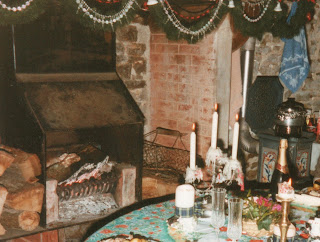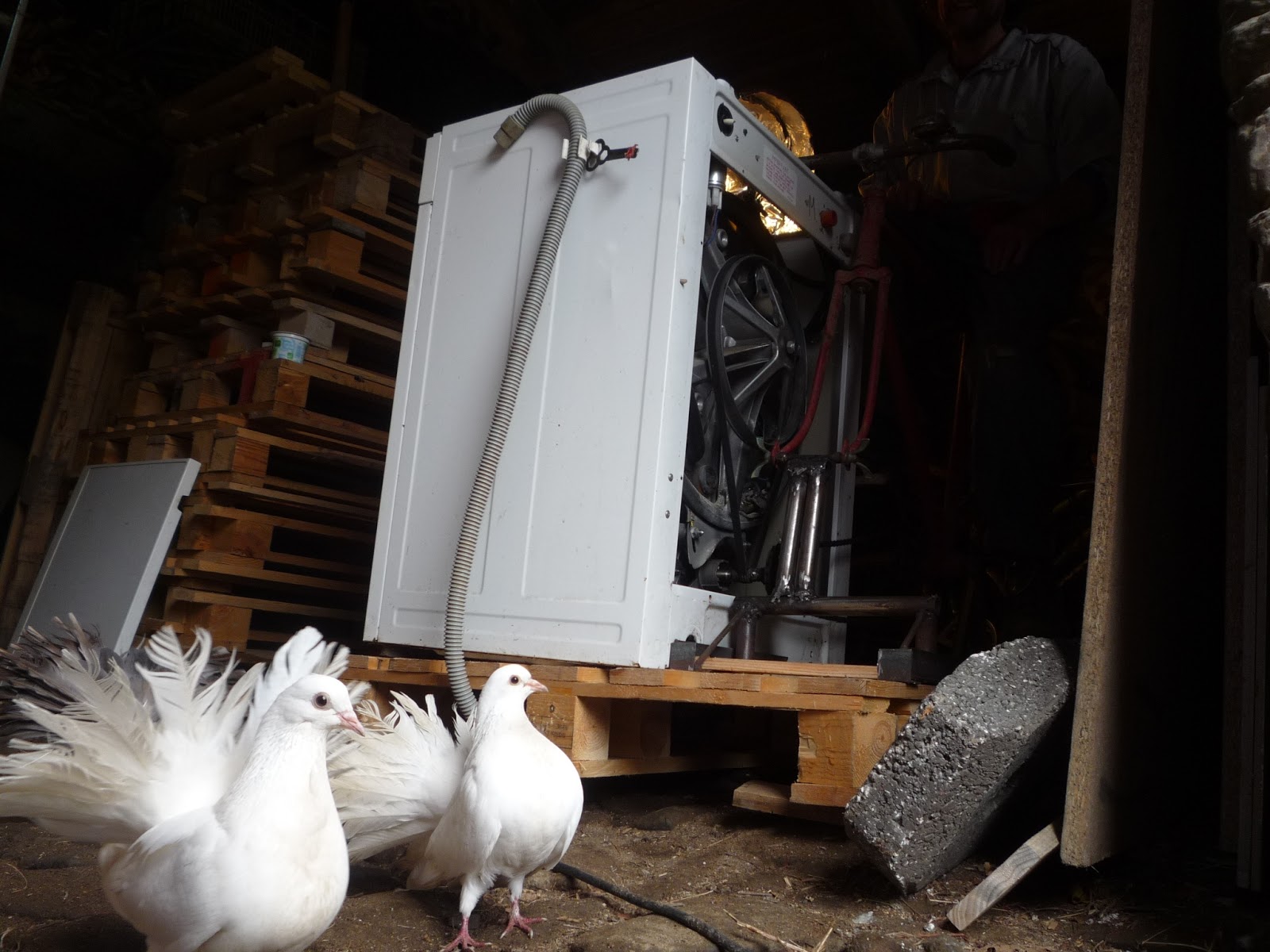This is a very interesting alternative energy project in that although it is used to heat an individual dwelling, in this case a farmhouse, it actually lies at the heart of what future energy conversion may be all about. There is a growing sense that energy and food production needs to be based around small communities.
Turning back the Clock
A few kilometres away from us is an organic dairy farm with a fine head of rare breed Normandy cows and from where we get our raw milk, cream, cider, honey, chicken grain and straw. The layout of the farm is the same as one sees in most parts of France, the buildings constructed mainly from locally sourced stone and clay, the extraction of the stone at the time of construction resulting in the formation of a large duck pond. On one side of the pool is the bread oven, still used to this day.The farm, as with our own house, has due to its its construction, a high thermal mass which makes the building warm in Winter and cool in Summer. Traditionally these farms had large open fireplaces upon which huge logs would be placed both for cooking and heating. These fires were fed from timber grown on the farm, and were highly inefficient at around 15%.
Going backwards to go forwards
The fields surrounding the farm are divided with hedges of deciduous wood. The hedges are trimmed every 15 years and the wood is used for fuel. This cycle has been going on for centuries, maintaining the hedgerows being an essential part of the farm calendar. Traditionally, the bigger branches were cut or split into logs for the fire and the thinner twigs would be collected, tied into bundles (faggots) which could be used in the bread oven. Over the last 80 years or so this latter use has become almost obsolete resulting in most farmers/landowners burning these smaller twigs in the fields where they were cut. This amounts to about one third of the total amount of combustible material being wasted.
The solution Michael and Lydie have adopted is to heat their large farm house using a wood chip boiler, the chips are produced from ALL of the hedge trimmings.
The solution Michael and Lydie have adopted is to heat their large farm house using a wood chip boiler, the chips are produced from ALL of the hedge trimmings.
 In this part of Normandie, there are hedges of a specific type known as bocages. This is an ancient hedging system, whereby the trees were planted on the top of lines of mounded up earth, lined with local stone. Thus, creating raised hedges and obviating the need for livestock fencing. Many of these, sadly have been grubbed out and flattened over the years but others have been preserved. Not only that but some farmers and homesteaders/smallholders are either replanting them or even reinstating the ones that have been destroyed. They are a haven for wild flowers and wildlife and I'm proud to say that we have one which runs along the whole side of our garden. If you have ever visited Cornwall or Devon, you will have seen similar beautiful hedge types.
In this part of Normandie, there are hedges of a specific type known as bocages. This is an ancient hedging system, whereby the trees were planted on the top of lines of mounded up earth, lined with local stone. Thus, creating raised hedges and obviating the need for livestock fencing. Many of these, sadly have been grubbed out and flattened over the years but others have been preserved. Not only that but some farmers and homesteaders/smallholders are either replanting them or even reinstating the ones that have been destroyed. They are a haven for wild flowers and wildlife and I'm proud to say that we have one which runs along the whole side of our garden. If you have ever visited Cornwall or Devon, you will have seen similar beautiful hedge types.Starting at source
On an appointed day a tractor and chipping unit arrive at the land where the wood to be shredded lies beside the trimmed hedge. On the day when we were there, the cut branches from 200m of hedge were converted into chips in one hour and 5 minutes, producing three large trailers full of fuel, sufficient for 18 months of heating of the farmhouse.
Here is a short clip of the chipper in action from our own files. The complete video of the whole system from hedge to hearth, embedded from our Youtube site will be shown at the end of this article.
Here is a short clip of the chipper in action from our own files. The complete video of the whole system from hedge to hearth, embedded from our Youtube site will be shown at the end of this article.
 The three fully laden trailers are taken back to the farm and the contents are piled in a hanger to dry. Michael told us it is possible to let the branches dry in the field prior to chipping, producing fuel that may be used immediately. The big disadvantage to this is that the cutters in the machine wear much more rapidly than when chipping 'greener' wood. So, if you have the space, let the easier-to-process chips dry in an open-sided shelter.
The three fully laden trailers are taken back to the farm and the contents are piled in a hanger to dry. Michael told us it is possible to let the branches dry in the field prior to chipping, producing fuel that may be used immediately. The big disadvantage to this is that the cutters in the machine wear much more rapidly than when chipping 'greener' wood. So, if you have the space, let the easier-to-process chips dry in an open-sided shelter.
After a few days in the shelter, the chip mound starts to naturally heat up, this heat drives the moisture out of the chips such that after 6 months they may be transported up to the rear of the farmhouse where there is a sheltered area next to the 'boiler room'. This means that the recently vacated shelter can then be used to store straw from the summer grain harvest.
The mound can attain temperatures as high as 80º C and theoretically one could extract this heat via a heat exchanger network to supplement the energy needs. The downside to this is that the drying mound would need to be near to the point where the heat is required, the size of the mound would mean another shelter near to the house. Plus any heat exchanger would be susceptible to damage from the machines needed to transfer the dried chips to their final destination. Additionally, there would be a problem of odour. The vapour that is emitted from the pile has a strong fragrance of alcohol.
Goodbye Mr. Chips
Now we come to the final destination of the wood chips, the boiler.
The dried chips are transferred to a loading bay in this case it is a corrugated iron sheeting silo of 4m³ capacity. Sited in the base of this is a trough in which a screw or auger operates to feed the chips into the boiler. Two spring arms rotate at intervals to sweep chips into the trough. the arms ensure that no voids can form above the trough. The screw feed and the sweeping arms' operation are controlled by the boiler.
When we were observing it they were actuated for 5 seconds every 30 seconds. The silo holds enough chips for about 3 weeks in the winter months.
When we were observing it they were actuated for 5 seconds every 30 seconds. The silo holds enough chips for about 3 weeks in the winter months.
The boiler functions automatically, feeding fuel and adjusting the amount of air needed for optimum combustion. The grate is emptied of ash which is then transferred to the ash box at regular intervals. There is a heat exchanger sited after the combustion chamber the exterior surfaces of which are also automatically cleaned to ensure optimum heat transfer.
The water heated in the exchanger passes into the coils of a 800l hot water tank. This tank provides the domestic hot water and the supply of heating water to the 15 radiators in the house. Thus the boiler is not running all the time and is re-ignited when the hot water tank temperature drops to a pre-determined point. An electrical resistance in the combustion area is used to ignite the wood.
Depending on the quality and type of wood chip being burned the ash box needs to be emptied at best every 3 weeks i.e. every 4m³ of wood chips, inferior wood such as willow will produce more ash that will require the emptying of the box every 10 days.
Pros and Cons
Pros
Using all of the trimmings from the hedges means that there is nearly 50% more fuel for heating and less pollution arising from burning the residue in the fields.
Locally sourced wood means very low fuel miles contributing to environmental impact of system.
Claimed efficiency of over 90% and low emissions means the boiler compares well with gas boilers.
Smokeless.
Ideal for small communities or a group of homesteads seeking a renewable source of heating.
Machines could be powered by Biodiesel to lessen environmental impact further.
Excellent for co-operatives (shared use of chipping equipment).
Cons
Expensive for small independent user if own production of chips desired.
Outbuilding required for bulk storage of chips.
Cannot function without electricity.
Initial cost of the system - 25,000 Euros, in some countries there is a subsidy for renewable energy start-up but the cost is still steep, in particular if you are also needing to hire the shredder and/or buy in wood for chipping or the chips themselves.
With the ever increasing price and rapid diminishing of resources, any form of heating which can process a renewable, sustainable fuel is worth serious consideration, especially in rural areas.
Our thanks go to Michael and Lydie for the time taken in showing their system to us and to Mother Nature for providing the wood.
Now, if you'd like to, sit back and watch the film:
Thanks for dropping by and please feel free to share this article, comment and/or ask questions and if you'd like to be assured of getting the next post, then sign up to follow this blog.
All the best, Andy
© Andy Colley 2014
























